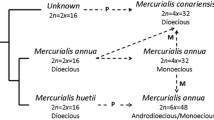Abstract
Sex-linked and sex-influenced inheritance are of interest because of their relation to the still intriguing problem of sex detrmination. Genes involved in the formation of the sex organs are regarded to be sex-determining genes. These genes may be present in all chromosomes including the sex-chromosomes. Other genes present in the sex-chromosomes, but not involved in sex determination, are the sex-linked genes. A mutation for narrow leaves we came across in ourM. ablum material is regarded as a case of sex linkage. Also the certation effect observed inM. album andM. dioicum must have been caused by genes on the sex-chromosomes. In both cases, however, it is not altogether unikekely, that the genes, regarded as sex-linked ones, actually take in the process of sex-determination.
Sex-determining genes might influence the effect of other genes, that are therefore called sex-influenced genes. We observed a number of such sex-influenced characters inMelandrium.
InM. album, female plants are, on the whole, larger than male plants, having larger stems and leaves. The petals, however, are larger in male plants, except in families with very broad petals. The leaves and petals are narrower in female plants than in male ones, except in families with very broad leaves and families with broad petals, where the difference in shape was no longer present. Usually, slightly more anthocyanin is formed in male plants than in females both in petals and the green parts. More glandular hairs were observed on male plants than on female ones.
Insofar the observations were made inM. dioicum the same results were obtained.
We regard these phenomena to be an expression of the different physiological conditions in female and in male plants, these conditions being provoked by the sex-determinging genes and more favourable for vegetative growth in female than in male plants.
Similar content being viewed by others
References
Baker, H. G. (1947).Melandrium album andM. diocicum in the Biological Flora of the Britisch Isles.J. Ecol. 35: 271–292.
Baker, H. G. (1948). The ecotypes ofMelandrium dioicum (L. emend.) Coss. and Germ.New Phytol. 47: 131–145.
Baker, H. G. (1951). The inheritance of certain characters in crosses betweenMelandrium dioicum andM. album.Genetica 25: 126–156.
Bateson, W. &E. R. Saunders (1902). Experimental studies on the physiology of heredity.Rep. to the Evol. Comm. of the Royal Soc. 1: 3–160.
Baur, E. (1910). Untersuchungen über die Vererbung von Chromatophoren merkmalen beiMelandrium, Antirrhinum undAquilegia.Z.I.A.V. 4: 81–102.
Baur, E. (1911). Einführung in die experimentelle Vererbungslehre. Borntraeger, Berlin.
Baur, E. (1912). Ein Fall von geschlechtsbegrenzter Vererbung beiMelandrium album.Z.I.A.V. 8: 335–336.
Correns, C. (1900). Ueber Levkoyenbastarde. Zur Kenntnis der Grenzen der Mendelschen Regeln.Bot. Zentralbl. 84: 111–126.
Correns, C. (1903). Über die dominierende Merkmale der Bastarde.Ber. Dtsch. Bot. Ges. 21: 133–147.
Correns, C. (1921). Zweite Fortsetzung der Versuche zur experimentellen Verschieben des Geschlechtsverhältnisses.Sitzungsber. d. Preuss. Akad. d. Wiss. Phys.-Mat. Klasse (1921): 330–354.
Correns, C. (1922). Alkohol und Zahlenverhältnis der Geschlechter bei einer getrennt geschlechtigen Pflanze (Melandrium).Naturw. 49: 1049–1052.
Correns, C. (1924). Über den Einflusz des Alters der Keimzellen. I.Sitzungsber. d. Preuss. Akad. d. Wiss. (1924): 70–104.
Correns, C. (1926). Über Fragen der Geschlechtsbestimmung bei höheren Pflanzen.Z.I.A.V. 41: 5–40.
Goebel, K. (1913). Organographie der Pflanzen. Gustav Fischer, Jena.
Hartshorne, J. W. (1963). The heterogametic sex in dioecious flowering plants.Genetics today, Proc. XI Intern. Congr. Genetics I: 232. Pergamon Press, Oxford.
Lawrence, C. W. (1963). Genetic studies on wild populations ofMelandrium. I. Chromosome behaviour.Heredity 18: 135–148.
Lawrence, C. W. (1964). Genetic studies on wild populations ofMelandrium. II. flowring time and plant weight.Heredity 19: 149–163.
Lawrence, C. W. (1964). Genetic studies on wild populations ofMelandrium. III.Heredity 19: 1–19.
Löve, D. (1944). Cytogenetic studies on dioecious Melandrium.Botan. Notiser (1944): 125–214.
Nigtvercht, G. van (1966). Genetic studies in dioeciousMelandrium. II. Sex determination inM. album andM. dioicum.Genetica 37: 307–344.
Schulz, A. (1890). Beiträge zur Kenntnis der Bestäubrungseinrichtungen und Geschlechtsverteilung bei den Pflanzen. II.Bibl. Bot. 17: 182–196.
Shull, G. H. (1910). Inheritance of sex inLychnis.Bot. Gaz. 52: 110–125.
Shull, G. H. (1911). Reversible sex-mutants inLychnis dioica.Bot. Gaz. 52: 329–368.
Shull, G. H. (1914). Sex-limited inheritance inLychnis dioica L..Z.I.A.V. 12: 265–302.
Stanfield, J. F. (1937). Certain physico-chemical aspects of sexual differentiation inLychnis dioica.Am. J. Bot. 24: 710–719.
Stanfield, J. F. (1944). Chemical composition of roots and tops of dioeciousLychnis in vegetative and flowering phases of growth.Plant Physicol. 19: 377–383.
Tutin, T. G., V. H. Heywood, N. A. Burges, D. H. Valentine, S. M. Walters &D. A. Webb (1964). Flora europaea. Cambridge Univ. Press. London.
Vries, H. de (1900). Das Spaltungsgesetz der Bastarde.Ber. Dtsch. Bot. Ges. 18: 83–90.
Vries, H. de (1903). Die Mutationstheorie. Bd.2. Veit & Comp., Leipzig.
Westergaard, M. (1946). Aberrant Y-chromosomes and sex expression inMelandrium album.Hereditas 32: 419–443.
Winger, Ø. (1917). The chromosomes. Their numbers and general importance.Comptes rendus du Lab. Carlsberg 13: 131–175.
Winge, Ø. (1927). On a Y-linked gene inMelandrium.Hereditas 9: 274–284.
Winge, Ø. (1931). X-and Y-linked inheritance inMelandrium.Hereditas 15: 127–165.
Winge, Ø. (1932). The nature of sex-chromosomes.Proc. Sixth Intern. Congr. Genetics 1: 343–355.
Author information
Authors and Affiliations
Rights and permissions
About this article
Cite this article
Van Nigtevecht, G. Genetic studies in dioecious melandrium. I. Genetica 37, 281–306 (1966). https://doi.org/10.1007/BF01547140
Received:
Issue Date:
DOI: https://doi.org/10.1007/BF01547140




